Nodulating Aeschynomene indica without Nod Factor Synthesis Genes: In Silico Analysis of Evolutionary Relationship
Abstract
:1. Introduction
2. Materials and Methods
2.1. Selection of Test Strains
2.2. Genome Sequencing, Splicing, Optimization
2.3. Genome Prediction, Annotation
2.4. Analysis of Functional Gene Components
2.5. Evolutionary Analysis of AIRs
3. Results and Discussion
3.1. Genome Profile
3.2. Analysis of the Origin of AIRs
3.3. Comparative Genome Analysis of AIRs
3.4. Analysis of Symbiotic Nitrogen Fixation Gene Components
3.5. Analysis of Photosynthetic Gene Components
3.6. Analysis of T3SS Components
3.7. Analysis of the Genetic Evolution of Bradyrhizobium
3.8. Analysis of Differential Genes in Bradyrhizobium
4. Conclusions
Supplementary Materials
Author Contributions
Funding
Data Availability Statement
Acknowledgments
Conflicts of Interest
References
- Zhang, Z.; Li, Y.; Pan, X.; Shao, S.; Liu, W.; Wang, E.T.; Xie, Z. Aeschynomene indica-Nodulating Rhizobia Lacking Nod Factor Synthesis Genes: Diversity and Evolution in Shandong Peninsula, China. Appl. Environ. Microbiol. 2019, 85, e00782-19. [Google Scholar] [CrossRef]
- Boivin, C.; Ndoye, I.; Molouba, F.; de Lajudie, P.; Dupuy, N.; Dreyfus, B.; de Bruijn, F.J. Stem Nodulation in Legumes: Diversity, Mechanisms, and Unusual Characteristics. Crit. Rev. Plant Sci. 1997, 16, 1–30. [Google Scholar] [CrossRef]
- Miche, L.; Moulin, L.; Chaintreuil, C.; Contreras-Jimenez, J.L.; Munive-Hernandez, J.A.; Del Carmen Villegas-Hernandez, M.; Crozier, F.; Bena, G. Diversity analyses of Aeschynomene symbionts in Tropical Africa and Central America reveal that nod-independent stem nodulation is not restricted to photosynthetic bradyrhizobia. Environ. Microbiol. 2010, 12, 2152–2164. [Google Scholar] [CrossRef]
- Molouba, F.; Lorquin, J.; Willems, A.; Hoste, B.; Giraud, E.; Dreyfus, B.; Gillis, M.; de Lajudie, P.; Masson-Boivin, C. Photosynthetic bradyrhizobia from Aeschynomene spp. are specific to stem-nodulated species and form a separate 16S ribosomal DNA restriction fragment length polymorphism group. Appl. Environ. Microbiol. 1999, 65, 3084–3094. [Google Scholar] [CrossRef] [PubMed]
- Mornico, D.; Miché, L.; Béna, G.; Nouwen, N.; Verméglio, A.; Vallenet, D.; Smith, A.A.; Giraud, E.; Médigue, C.; Moulin, L. Comparative genomics of Aeschynomene symbionts: Insights into the ecological lifestyle of nod-independent photosynthetic bradyrhizobia. Genes 2011, 3, 35–61. [Google Scholar] [CrossRef] [PubMed]
- Avontuur, J.R.; Palmer, M.; Beukes, C.W.; Chan, W.Y.; Coetzee, M.P.A.; Blom, J.; Stępkowski, T.; Kyrpides, N.C.; Woyke, T.; Shapiro, N.; et al. Genome-informed Bradyrhizobium taxonomy: Where to from here? Syst. Appl. Microbiol. 2019, 42, 427–439. [Google Scholar] [CrossRef]
- Bonaldi, K.; Gargani, D.; Prin, Y.; Fardoux, J.; Gully, D.; Nouwen, N.; Goormachtig, S.; Giraud, E. Nodulation of Aeschynomene afraspera and A. indica by photosynthetic Bradyrhizobium Sp. strain ORS285: The nod-dependent versus the nod-independent symbiotic interaction. Mol. Plant Microbe Interact. 2011, 24, 1359–1371. [Google Scholar] [CrossRef]
- Chaintreuil, C.; Gully, D.; Hervouet, C.; Tittabutr, P.; Randriambanona, H.; Brown, S.C.; Lewis, G.P.; Bourge, M.; Cartieaux, F.; Boursot, M.; et al. The evolutionary dynamics of ancient and recent polyploidy in the African semiaquatic species of the legume genus Aeschynomene. New Phytol. 2016, 211, 1077–1091. [Google Scholar] [CrossRef] [PubMed]
- Avontuur, J.R.; Wilken, P.M.; Palmer, M.; Coetzee, M.P.A.; Stępkowski, T.; Venter, S.N.; Steenkamp, E.T. Complex evolutionary history of photosynthesis in Bradyrhizobium. Microb. Genom. 2023, 9, 001105. [Google Scholar] [CrossRef]
- Wettlaufer, S.H.; Hardy, R.W. Effect of Light and Organic Acids on Oxygen Uptake by BTAi 1, a Photosynthetic Rhizobium. Appl. Environ. Microbiol. 1992, 58, 3830–3833. [Google Scholar] [CrossRef]
- Evans, W.R.; Fleischman, D.E.; Calvert, H.E.; Pyati, P.V.; Alter, G.M.; Rao, N.S. Bacteriochlorophyll and Photosynthetic Reaction Centers in Rhizobium Strain BTAi 1. Appl. Environ. Microbiol. 1990, 56, 3445–3449. [Google Scholar] [CrossRef] [PubMed]
- Okubo, T.; Fukushima, S.; Itakura, M.; Oshima, K.; Longtonglang, A.; Teaumroong, N.; Mitsui, H.; Hattori, M.; Hattori, R.; Hattori, T.; et al. Genome analysis suggests that the soil oligotrophic bacterium Agromonas oligotrophica (Bradyrhizobium oligotrophicum) is a nitrogen-fixing symbiont of Aeschynomene indica. Appl. Environ. Microbiol. 2013, 79, 2542–2551. [Google Scholar] [CrossRef] [PubMed]
- Yurkov, V.; Beatty, J.T. Isolation of aerobic anoxygenic photosynthetic bacteria from black smoker plume waters of the juan de fuca ridge in the pacific ocean. Appl. Environ. Microbiol. 1998, 64, 337–341. [Google Scholar] [CrossRef] [PubMed]
- Knaff, D.B. Anoxygenic photosynthetic bacteria. Photosynth. Res. 1996, 47, 199–200. [Google Scholar] [CrossRef]
- Jaubert, M.; Vuillet, L.; Hannibal, L.; Adriano, J.M.; Fardoux, J.; Bouyer, P.; Bonaldi, K.; Fleischman, D.; Giraud, E.; Verméglio, A. Control of peripheral light-harvesting complex synthesis by a bacteriophytochrome in the aerobic photosynthetic bacterium Bradyrhizobium strain BTAi1. J. Bacteriol. 2008, 190, 5824–5831. [Google Scholar] [CrossRef] [PubMed]
- Giraud, E.; Hannibal, L.; Fardoux, J.; Vermeglio, A.; Dreyfus, B. Effect of Bradyrhizobium photosynthesis on stem nodulation of Aeschynomene sensitiva. Proc. Natl. Acad. Sci. USA 2000, 97, 14795–14800. [Google Scholar] [CrossRef]
- Tank, M.; Thiel, V.; Imhoff, J.F. Phylogenetic relationship of phototrophic purple sulfur bacteria according to pufL and pufM genes. Int. Microbiol. 2009, 12, 175–185. [Google Scholar]
- Chen, W.F.; Wang, E.T.; Ji, Z.J.; Zhang, J.J. Recent development and new insight of diversification and symbiosis specificity of legume rhizobia: Mechanism and application. J. Appl. Microbiol. 2021, 131, 553–563. [Google Scholar] [CrossRef]
- Giraud, E.; Moulin, L.; Vallenet, D.; Barbe, V.; Cytryn, E.; Avarre, J.C.; Jaubert, M.; Simon, D.; Cartieaux, F.; Prin, Y.; et al. Legumes symbioses: Absence of Nod genes in photosynthetic bradyrhizobia. Science 2007, 316, 1307–1312. [Google Scholar] [CrossRef]
- Guha, S.; Molla, F.; Sarkar, M.; Ibañez, F.; Fabra, A.; DasGupta, M. Nod factor-independent ‘crack-entry’ symbiosis in dalbergoid legume Arachis hypogaea. Environ. Microbiol. 2022, 24, 2732–2746. [Google Scholar] [CrossRef]
- Busset, N.; Di Lorenzo, F.; Palmigiano, A.; Sturiale, L.; Gressent, F.; Fardoux, J.; Gully, D.; Chaintreuil, C.; Molinaro, A.; Silipo, A.; et al. The Very Long Chain Fatty Acid (C26:25OH) Linked to the Lipid A Is Important for the Fitness of the Photosynthetic Bradyrhizobium Strain ORS278 and the Establishment of a Successful Symbiosis with Aeschynomene Legumes. Front. Microbiol. 2017, 8, 1821. [Google Scholar] [CrossRef]
- Teulet, A.; Busset, N.; Fardoux, J.; Gully, D.; Chaintreuil, C.; Cartieaux, F.; Jauneau, A.; Comorge, V.; Okazaki, S.; Kaneko, T.; et al. The rhizobial type III effector ErnA confers the ability to form nodules in legumes. Proc. Natl. Acad. Sci. USA 2019, 116, 21758–21768. [Google Scholar] [CrossRef] [PubMed]
- Teulet, A.; Gully, D.; Rouy, Z.; Camuel, A.; Koebnik, R.; Giraud, E.; Lassalle, F. Phylogenetic distribution and evolutionary dynamics of nod and T3SS genes in the genus Bradyrhizobium. Microb. Genom. 2020, 6, e000407. [Google Scholar] [CrossRef] [PubMed]
- Camuel, A.; Teulet, A.; Carcagno, M.; Haq, F.; Pacquit, V.; Gully, D.; Pervent, M.; Chaintreuil, C.; Fardoux, J.; Horta-Araujo, N.; et al. Widespread Bradyrhizobium distribution of diverse Type III effectors that trigger legume nodulation in the absence of Nod factor. ISME J. 2023, 17, 1416–1429. [Google Scholar] [CrossRef] [PubMed]
- Weston, L.A.; Mathesius, U. Flavonoids: Their structure, biosynthesis and role in the rhizosphere, including allelopathy. J. Chem. Ecol. 2013, 39, 283–297. [Google Scholar] [CrossRef] [PubMed]
- Bosse, M.A.; Silva, M.B.D.; Oliveira, N.; Araujo, M.A.; Rodrigues, C.; Azevedo, J.P.; Reis, A.R.D. Physiological impact of flavonoids on nodulation and ureide metabolism in legume plants. Plant Physiol. Biochem. 2021, 166, 512–521. [Google Scholar] [CrossRef] [PubMed]
- Wassem, R.; Kobayashi, H.; Kambara, K.; Le Quere, A.; Walker, G.C.; Broughton, W.J.; Deakin, W.J. TtsI regulates symbiotic genes in Rhizobium species NGR234 by binding to tts boxes. Mol. Microbiol. 2008, 68, 736–748. [Google Scholar] [CrossRef] [PubMed]
- Pérez-Montaño, F.; Jiménez-Guerrero, I.; Acosta-Jurado, S.; Navarro-Gómez, P.; Ollero, F.J.; Ruiz-Sainz, J.E.; López-Baena, F.J.; Vinardell, J.M. A transcriptomic analysis of the effect of genistein on Sinorhizobium fredii HH103 reveals novel rhizobial genes putatively involved in symbiosis. Sci. Rep. 2016, 6, 31592. [Google Scholar] [CrossRef] [PubMed]
- Arashida, H.; Odake, H.; Sugawara, M.; Noda, R.; Kakizaki, K.; Ohkubo, S.; Mitsui, H.; Sato, S.; Minamisawa, K. Evolution of rhizobial symbiosis islands through insertion sequence-mediated deletion and duplication. ISME J. 2022, 16, 112–121. [Google Scholar] [CrossRef]
- Dagan, T.; Martin, W. Ancestral genome sizes specify the minimum rate of lateral gene transfer during prokaryote evolution. Proc. Natl. Acad. Sci. USA 2007, 104, 870–875. [Google Scholar] [CrossRef]
- Arnold, B.J.; Huang, I.T.; Hanage, W.P. Horizontal gene transfer and adaptive evolution in bacteria. Nat. Rev. Microbiol. 2022, 20, 206–218. [Google Scholar] [CrossRef] [PubMed]
- Liu, S.; Jiao, J.; Tian, C.F. Adaptive Evolution of Rhizobial Symbiosis beyond Horizontal Gene Transfer: From Genome Innovation to Regulation Reconstruction. Genes 2023, 14, 274. [Google Scholar] [CrossRef] [PubMed]
- Prjibelski, A.; Antipov, D.; Meleshko, D.; Lapidus, A.; Korobeynikov, A. Using SPAdes De Novo Assembler. Curr. Protoc. Bioinform. 2020, 70, e102. [Google Scholar] [CrossRef] [PubMed]
- Walker, B.J.; Abeel, T.; Shea, T.; Priest, M.; Abouelliel, A.; Sakthikumar, S.; Cuomo, C.A.; Zeng, Q.; Wortman, J.; Young, S.K.; et al. Pilon: An integrated tool for comprehensive microbial variant detection and genome assembly improvement. PLoS ONE 2014, 9, e112963. [Google Scholar] [CrossRef]
- Du, Z.; Wu, Q.; Wang, T.; Chen, D.; Huang, X.; Yang, W.; Luo, W. BlastGUI: A Python-based Cross-platform Local BLAST Visualization Software. Mol. Inform. 2020, 39, e1900120. [Google Scholar] [CrossRef] [PubMed]
- Emms, D.M.; Kelly, S. OrthoFinder: Phylogenetic orthology inference for comparative genomics. Genome Biol. 2019, 20, 238. [Google Scholar] [CrossRef]
- Letunic, I.; Bork, P. Interactive Tree Of Life (iTOL) v5: An online tool for phylogenetic tree display and annotation. Nucleic Acids Res. 2021, 49, W293–W296. [Google Scholar] [CrossRef] [PubMed]
- Hyatt, D.; Chen, G.L.; Locascio, P.F.; Land, M.L.; Larimer, F.W.; Hauser, L.J. Prodigal: Prokaryotic gene recognition and translation initiation site identification. BMC Bioinform. 2010, 11, 119. [Google Scholar] [CrossRef] [PubMed]
- Buchfink, B.; Xie, C.; Huson, D.H. Fast and sensitive protein alignment using DIAMOND. Nat. Methods 2015, 12, 59–60. [Google Scholar] [CrossRef]
- Reau, M.; Lagarde, N.; Zagury, J.F.; Montes, M. Nuclear Receptors Database Including Negative Data (NR-DBIND): A Database Dedicated to Nuclear Receptors Binding Data Including Negative Data and Pharmacological Profile. J. Med. Chem. 2019, 62, 2894–2904. [Google Scholar] [CrossRef]
- Gasteiger, E.; Jung, E.; Bairoch, A. SWISS-PROT: Connecting biomolecular knowledge via a protein database. Curr. Issues Mol. Biol. 2001, 3, 47–55. [Google Scholar] [CrossRef] [PubMed]
- Rasche, H.; Hiltemann, S. Galactic Circos: User-friendly Circos plots within the Galaxy platform. Gigascience 2020, 9, giaa065. [Google Scholar] [CrossRef]
- Kanehisa, M.; Furumichi, M.; Sato, Y.; Kawashima, M.; Ishiguro-Watanabe, M. KEGG for taxonomy-based analysis of pathways and genomes. Nucleic Acids Res. 2022, 51, D587–D592. [Google Scholar] [CrossRef] [PubMed]
- Chauhan, A.; Rathore, R.S.; Agarwal, M.; Chauhan, A.J.; Taywade, A. Friend or Foe: Draft Genome Sequence of Bradyrhizobium sp. Strain SRS-191. Microbiol. Resour. Announc. 2022, 11, e0075322. [Google Scholar] [CrossRef]
- Toniutti, M.A.; Albicoro, F.J.; Castellani, L.G.; Lopez Garcia, S.L.; Fornasero, L.V.; Zuber, N.E.; Vera, L.M.; Vacca, C.; Cafiero, J.H.; Winkler, A.; et al. Genome sequence of Bradyrhizobium yuanmingense strain P10 130, a highly efficient nitrogen-fixing bacterium that could be used for Desmodium incanum inoculation. Gene 2021, 768, 145267. [Google Scholar] [CrossRef]
- Krishnan, H.B.; Kim, W.S.; Givan, S.A. Draft Genome Sequence of Bradyrhizobium sp. Strain LVM 105, a Nitrogen-Fixing Symbiont of Chamaecrista fasciculata (Michx.) Greene. Microbiol. Resour. Announc. 2019, 8, e00132-19. [Google Scholar] [CrossRef]
- Bromfield, E.S.P.; Cloutier, S.; Nguyen, H.D.T. Description and complete genome sequences of Bradyrhizobium symbiodeficiens sp. nov., a non-symbiotic bacterium associated with legumes native to Canada. Int. J. Syst. Evol. Microbiol. 2020, 70, 442–449. [Google Scholar] [CrossRef] [PubMed]
- Sun, L.; Zhang, Z.; Dong, X.; Tang, Z.; Ju, B.; Du, Z.; Wang, E.; Xie, Z. Bradyrhizobium aeschynomenes sp. nov., a root and stem nodule microsymbiont of Aeschynomene indica. Syst. Appl. Microbiol. 2022, 45, 126337. [Google Scholar] [CrossRef] [PubMed]
- Rejili, M.; Off, K.; Brachmann, A.; Marin, M. Bradyrhizobium hipponense sp. nov., isolated from Lupinus angustifolius growing in the northern region of Tunisia. Int. J. Syst. Evol. Microbiol. 2020, 70, 5539–5550. [Google Scholar] [CrossRef]
- Simoes-Araujo, J.L.; Leite, J.; Passos, S.R.; Xavier, G.R.; Rumjanek, N.G.; Zilli, J.E. Draft genome sequence of Bradyrhizobium sp. strain BR 3267, an elite strain recommended for cowpea inoculation in Brazil. Braz. J. Microbiol 2016, 47, 781–782. [Google Scholar] [CrossRef]
- Zhang, N.; Jin, C.Z.; Zhuo, Y.; Li, T.; Jin, F.J.; Lee, H.G.; Jin, L. Genetic diversity into a novel free-living species of Bradyrhizobium from contaminated freshwater sediment. Front. Microbiol. 2023, 14, 1295854. [Google Scholar] [CrossRef] [PubMed]
- Tomkins, J.P.; Wood, T.C.; Stacey, M.G.; Loh, J.T.; Judd, A.; Goicoechea, J.L.; Stacey, G.; Sadowsky, M.J.; Wing, R.A. A marker-dense physical map of the Bradyrhizobium japonicum genome. Genome Res. 2001, 11, 1434–1440. [Google Scholar] [CrossRef] [PubMed]
- Blommaert, J. Genome size evolution: Towards new model systems for old questions. Proc. Biol. Sci. 2020, 287, 20201441. [Google Scholar] [CrossRef] [PubMed]
- Nouwen, N.; Chaintreuil, C.; Fardoux, J.; Giraud, E. A glutamate synthase mutant of Bradyrhizobium sp. strain ORS285 is unable to induce nodules on Nod factor-independent Aeschynomene species. Sci. Rep. 2021, 11, 20910. [Google Scholar] [CrossRef] [PubMed]
- Stępkowski, T.; Watkin, E.; McInnes, A.; Gurda, D.; Gracz, J.; Steenkamp, E.T. Distinct Bradyrhizbium communities nodulate legumes native to temperate and tropical monsoon Australia. Mol. Phylogenet. Evol. 2012, 63, 265–277. [Google Scholar] [CrossRef] [PubMed]
- Sprent, J.I.; Ardley, J.; James, E.K. Biogeography of nodulated legumes and their nitrogen-fixing symbionts. New Phytol. 2017, 215, 40–56. [Google Scholar] [CrossRef] [PubMed]
- Beukes, C.W.; Stępkowski, T.; Venter, S.N.; Cłapa, T.; Phalane, F.L.; le Roux, M.M.; Steenkamp, E.T. Crotalarieae and Genisteae of the South African Great Escarpment are nodulated by novel Bradyrhizobium species with unique and diverse symbiotic loci. Mol. Phylogenet. Evol. 2016, 100, 206–218. [Google Scholar] [CrossRef] [PubMed]
- Cloutier, S.; Bromfield, E.S.P. Analysis of the Complete Genome Sequence of the Widely Studied Strain Bradyrhizobium betae PL7HG1(T) Reveals the Presence of Photosynthesis Genes and a Putative Plasmid. Microbiol. Resour. Announc. 2019, 8, 01282-19. [Google Scholar] [CrossRef] [PubMed]
- Brown, S.D.; Utturkar, S.M.; Klingeman, D.M.; Johnson, C.M.; Martin, S.L.; Land, M.L.; Lu, T.Y.; Schadt, C.W.; Doktycz, M.J.; Pelletier, D.A. Twenty-one genome sequences from Pseudomonas species and 19 genome sequences from diverse bacteria isolated from the rhizosphere and endosphere of Populus deltoides. J. Bacteriol. 2012, 194, 5991–5993. [Google Scholar] [CrossRef]
- Fabra, A.; Castro, S.; Taurian, T.; Angelini, J.; Ibañez, F.; Dardanelli, M.; Tonelli, M.; Bianucci, E.; Valetti, L. Interaction among Arachis hypogaea L. (peanut) and beneficial soil microorganisms: How much is it known? Crit. Rev. Microbiol. 2010, 36, 179–194. [Google Scholar] [CrossRef]
- Stecher, B.; Maier, L.; Hardt, W.D. ‘Blooming’ in the gut: How dysbiosis might contribute to pathogen evolution. Nat. Rev. Microbiol. 2013, 11, 277–284. [Google Scholar] [CrossRef]
- Doucet-Populaire, F.; Trieu-Cuot, P.; Dosbaa, I.; Andremont, A.; Courvalin, P. Inducible transfer of conjugative transposon Tn1545 from Enterococcus faecalis to Listeria monocytogenes in the digestive tracts of gnotobiotic mice. Antimicrob. Agents Chemother. 1991, 35, 185–187. [Google Scholar] [CrossRef]
- Sun, J.; Qiu, Y.; Ding, P.; Peng, P.; Yang, H.; Li, L. Conjugative Transfer of Dioxin-Catabolic Megaplasmids and Bioaugmentation Prospects of a Rhodococcus sp. Environ. Sci. Technol. 2017, 51, 6298–6307. [Google Scholar] [CrossRef]
- Kim, M.K.; Ha, H.S.; Choi, S.U. Conjugal transfer using the bacteriophage phiC31 att/int system and properties of the attB site in Streptomyces ambofaciens. Biotechnol. Lett. 2008, 30, 695–699. [Google Scholar] [CrossRef] [PubMed]
- Hulin, M.T.; Rabiey, M.; Zeng, Z.; Vadillo Dieguez, A.; Bellamy, S.; Swift, P.; Mansfield, J.W.; Jackson, R.W.; Harrison, R.J. Genomic and functional analysis of phage-mediated horizontal gene transfer in Pseudomonas syringae on the plant surface. New Phytol. 2023, 237, 959–973. [Google Scholar] [CrossRef]
- González-Villalobos, E.; Balcázar, J.L. Does phage-mediated horizontal gene transfer represent an environmental risk? Trends Microbiol. 2022, 30, 1022–1024. [Google Scholar] [CrossRef]
- Kenzaka, T.; Tani, K.; Nasu, M. High-frequency phage-mediated gene transfer in freshwater environments determined at single-cell level. ISME J. 2010, 4, 648–659. [Google Scholar] [CrossRef] [PubMed]
- Baev, N.; Schultze, M.; Barlier, I.; Ha, D.C.; Virelizier, H.; Kondorosi, E.; Kondorosi, A. Rhizobium nodM and nodN genes are common nod genes: nodM encodes functions for efficiency of nod signal production and bacteroid maturation. J. Bacteriol. 1992, 174, 7555–7565. [Google Scholar] [CrossRef] [PubMed]
- Yan, H.; Xie, J.B.; Ji, Z.J.; Yuan, N.; Tian, C.F.; Ji, S.K.; Wu, Z.Y.; Zhong, L.; Chen, W.X.; Du, Z.L.; et al. Evolutionarily Conserved nodE, nodO, T1SS, and Hydrogenase System in Rhizobia of Astragalus membranaceus and Caragana intermedia. Front. Microbiol. 2017, 8, 2282. [Google Scholar] [CrossRef]
- Ke, X.; Xiao, H.; Peng, Y.; Wang, J.; Lv, Q.; Wang, X. Phosphoenolpyruvate reallocation links nitrogen fixation rates to root nodule energy state. Science 2022, 378, 971–977. [Google Scholar] [CrossRef]
- Lindström, K.; Mousavi, S.A. Effectiveness of nitrogen fixation in rhizobia. Microb. Biotechnol. 2020, 13, 1314–1335. [Google Scholar] [CrossRef]
- Okubo, T.; Tsukui, T.; Maita, H.; Okamoto, S.; Oshima, K.; Fujisawa, T.; Saito, A.; Futamata, H.; Hattori, R.; Shimomura, Y.; et al. Complete genome sequence of Bradyrhizobium sp. S23321: Insights into symbiosis evolution in soil oligotrophs. Microbes Environ. 2012, 27, 306–315. [Google Scholar] [CrossRef]
- Sun, T.; Wang, P.; Rao, S.; Zhou, X.; Wrightstone, E.; Lu, S.; Yuan, H.; Yang, Y.; Fish, T.; Thannhauser, T.; et al. Co-chaperoning of chlorophyll and carotenoid biosynthesis by ORANGE family proteins in plants. Mol. Plant 2023, 16, 1048–1065. [Google Scholar] [CrossRef]
- Okazaki, S.; Tittabutr, P.; Teulet, A.; Thouin, J.; Fardoux, J.; Chaintreuil, C.; Gully, D.; Arrighi, J.F.; Furuta, N.; Miwa, H.; et al. Rhizobium-legume symbiosis in the absence of Nod factors: Two possible scenarios with or without the T3SS. ISME J. 2016, 10, 64–74. [Google Scholar] [CrossRef]
- Teulet, A.; Camuel, A.; Perret, X.; Giraud, E. The Versatile Roles of Type III Secretion Systems in Rhizobium-Legume Symbioses. Annu. Rev. Microbiol. 2022, 76, 45–65. [Google Scholar] [CrossRef]
- Okazaki, S.; Kaneko, T.; Sato, S.; Saeki, K. Hijacking of leguminous nodulation signaling by the rhizobial type III secretion system. Proc. Natl. Acad. Sci. USA 2013, 110, 17131–17136. [Google Scholar] [CrossRef]
- Periwal, V.; Scaria, V. Insights into structural variations and genome rearrangements in prokaryotic genomes. Bioinformatics 2015, 31, 1–9. [Google Scholar] [CrossRef]
- Polz, M.F.; Alm, E.J.; Hanage, W.P. Horizontal gene transfer and the evolution of bacterial and archaeal population structure. Trends Genet. 2013, 29, 170–175. [Google Scholar] [CrossRef]
- Kelly, S. The economics of organellar gene loss and endosymbiotic gene transfer. Genome Biol. 2021, 22, 345. [Google Scholar] [CrossRef] [PubMed]
- de Mattos, K.; Viger, R.S.; Tremblay, J.J. Transcription Factors in the Regulation of Leydig Cell Gene Expression and Function. Front. Endocrinol. 2022, 13, 881309. [Google Scholar] [CrossRef] [PubMed]
- Chaintreuil, C.; Perrier, X.; Martin, G.; Fardoux, J.; Lewis, G.P.; Brottier, L.; Rivallan, R.; Gomez-Pacheco, M.; Bourges, M.; Lamy, L.; et al. Naturally occurring variations in the nod-independent model legume Aeschynomene evenia and relatives: A resource for nodulation genetics. BMC Plant Biol. 2018, 18, 54. [Google Scholar] [CrossRef] [PubMed]
- Schüler, L.M.; Bombo, G.; Duarte, P.; Santos, T.F.; Maia, I.B.; Pinheiro, F.; Marques, J.; Jacinto, R.; Schulze, P.S.C.; Pereira, H.; et al. Carotenoid biosynthetic gene expression, pigment and n-3 fatty acid contents in carotenoid-rich Tetraselmis striata CTP4 strains under heat stress combined with high light. Bioresour. Technol. 2021, 337, 125385. [Google Scholar] [CrossRef] [PubMed]
- Zhou, X.; Rao, S.; Wrightstone, E.; Sun, T.; Lui, A.C.W.; Welsch, R.; Li, L. Phytoene Synthase: The Key Rate-Limiting Enzyme of Carotenoid Biosynthesis in Plants. Front. Plant Sci. 2022, 13, 884720. [Google Scholar] [CrossRef] [PubMed]
- Koschmieder, J.; Fehling-Kaschek, M.; Schaub, P.; Ghisla, S.; Brausemann, A.; Timmer, J.; Beyer, P. Plant-type phytoene desaturase: Functional evaluation of structural implications. PLoS ONE 2017, 12, e0187628. [Google Scholar] [CrossRef] [PubMed]
- Wang, S.; Zhuang, K.; Zhang, S.; Yang, M.; Kong, F.; Meng, Q. Overexpression of a tomato carotenoid ε-hydroxylase gene (SlLUT1) improved the drought tolerance of transgenic tobacco. J. Plant Physiol. 2018, 222, 103–112. [Google Scholar] [CrossRef]
- Lu, S.; Zhang, Y.; Zheng, X.; Zhu, K.; Xu, Q.; Deng, X. Isolation and Functional Characterization of a Lycopene β-cyclase Gene Promoter from Citrus. Front. Plant Sci. 2016, 7, 1367. [Google Scholar] [CrossRef]
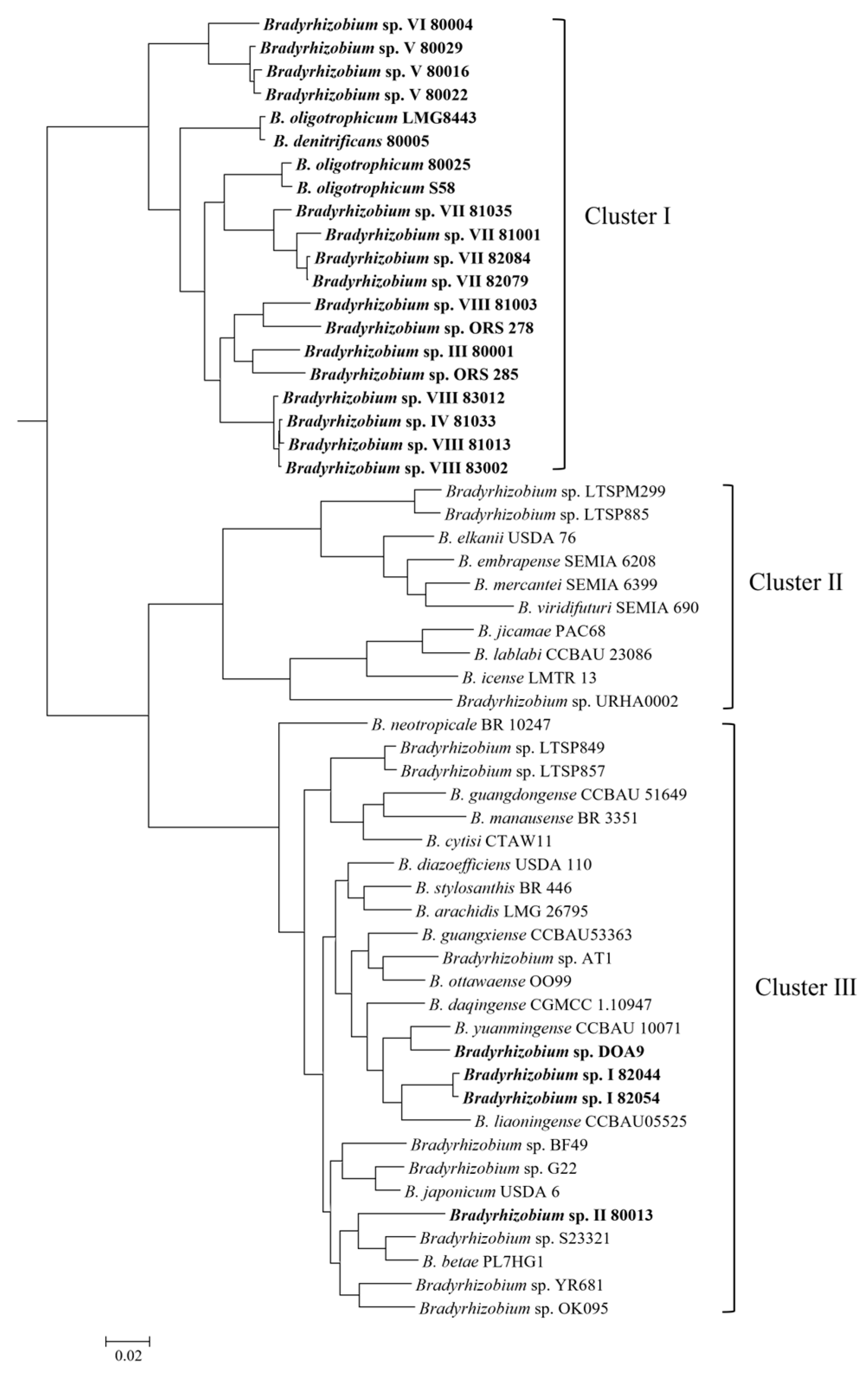


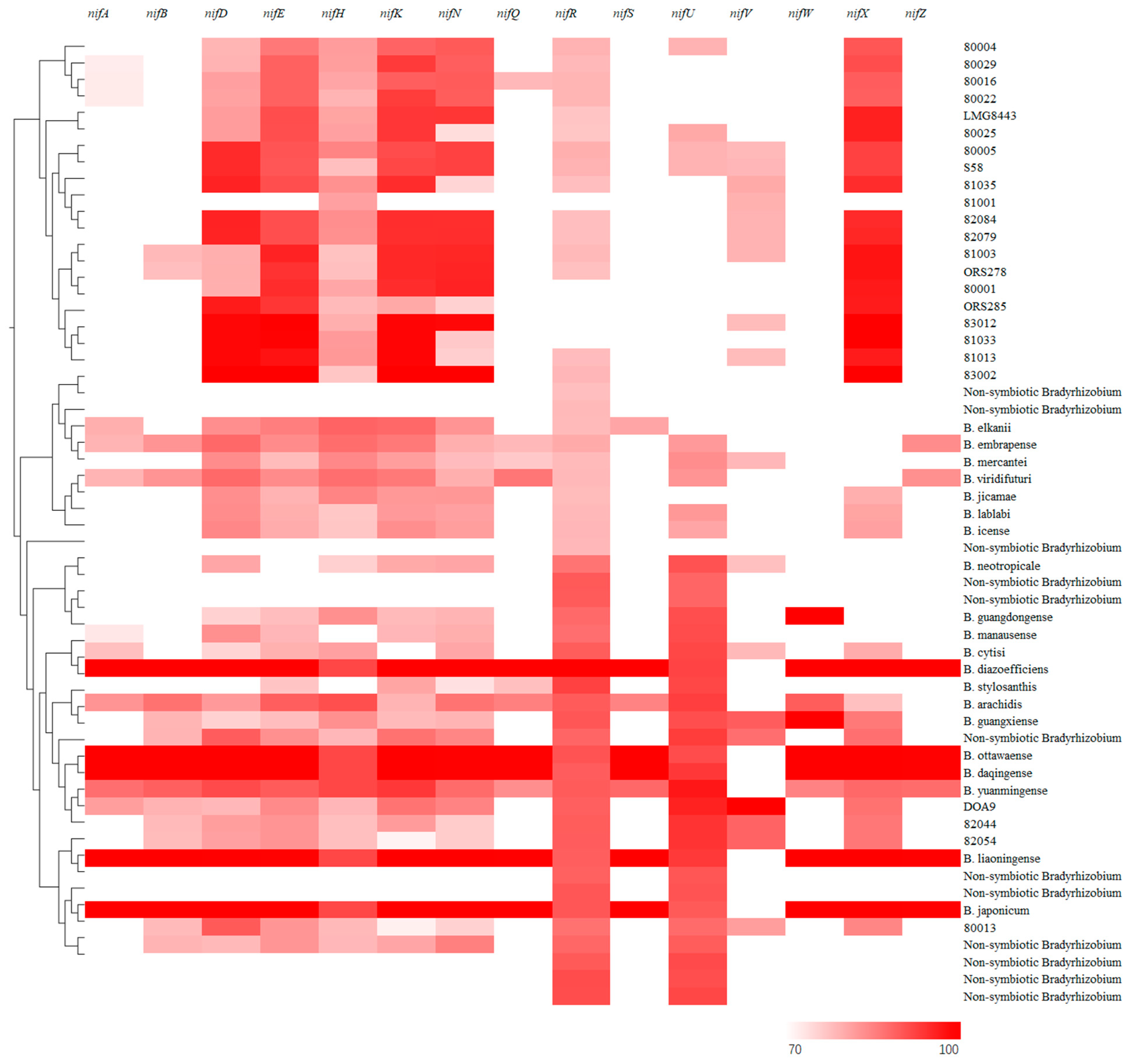



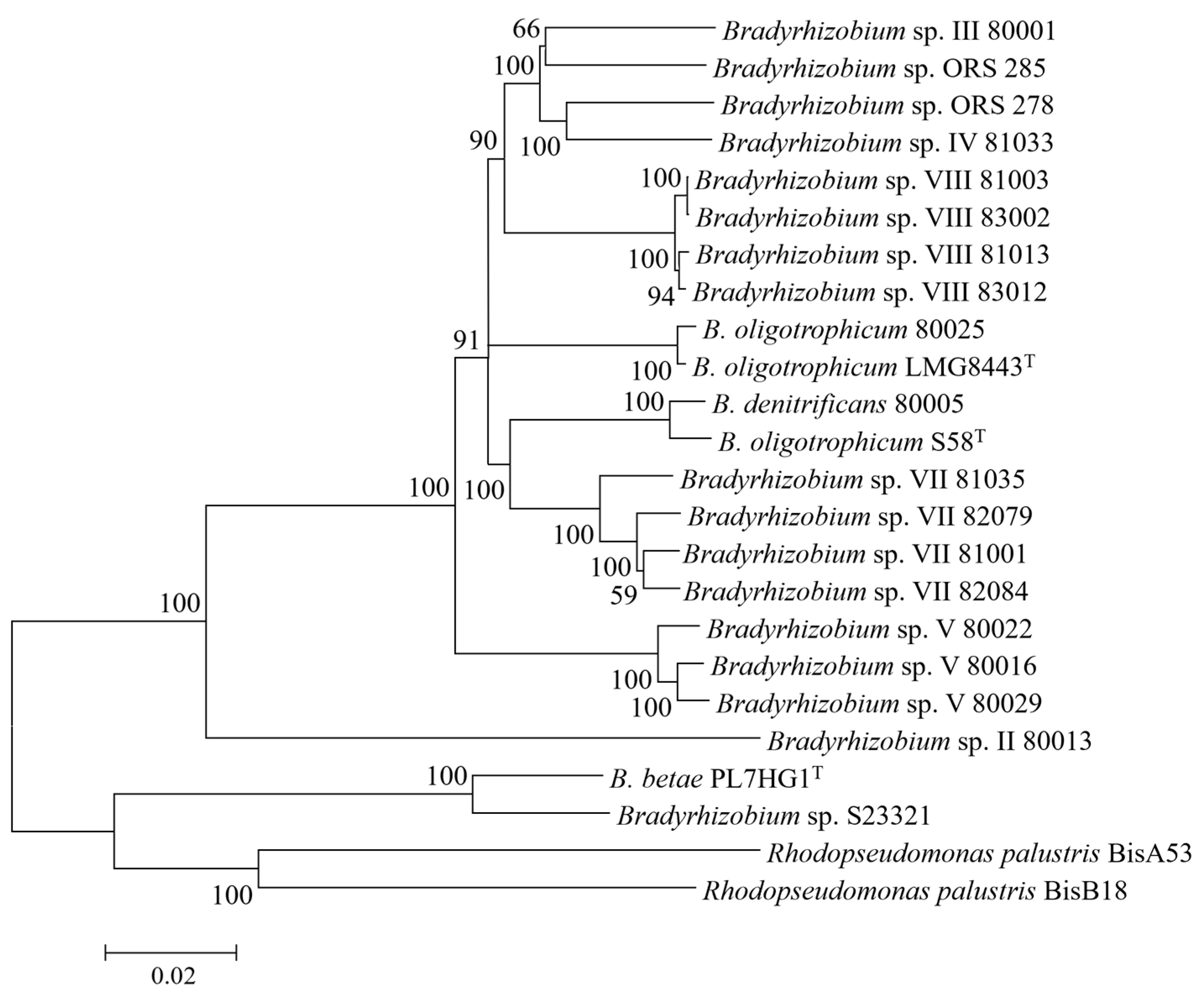
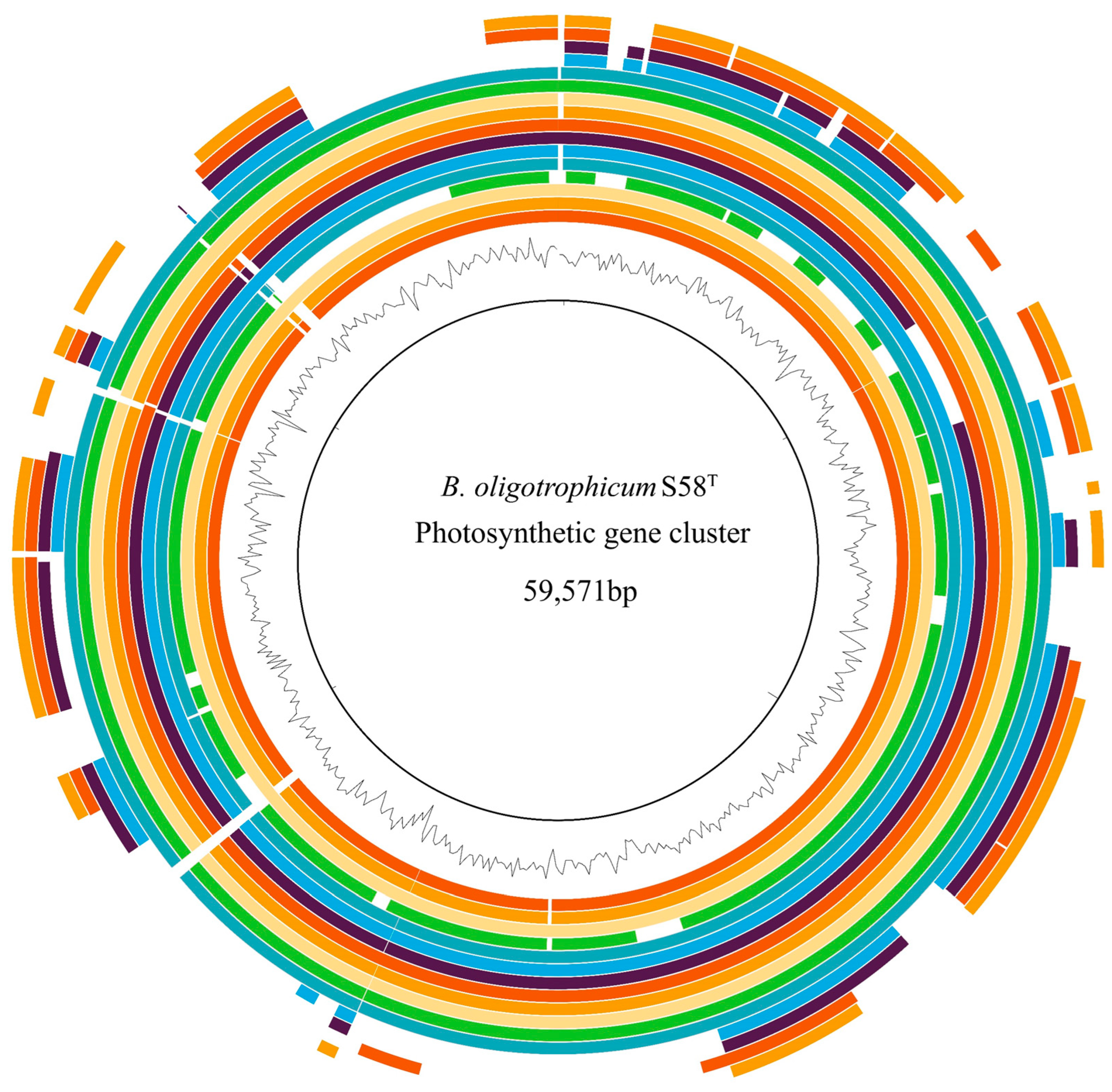
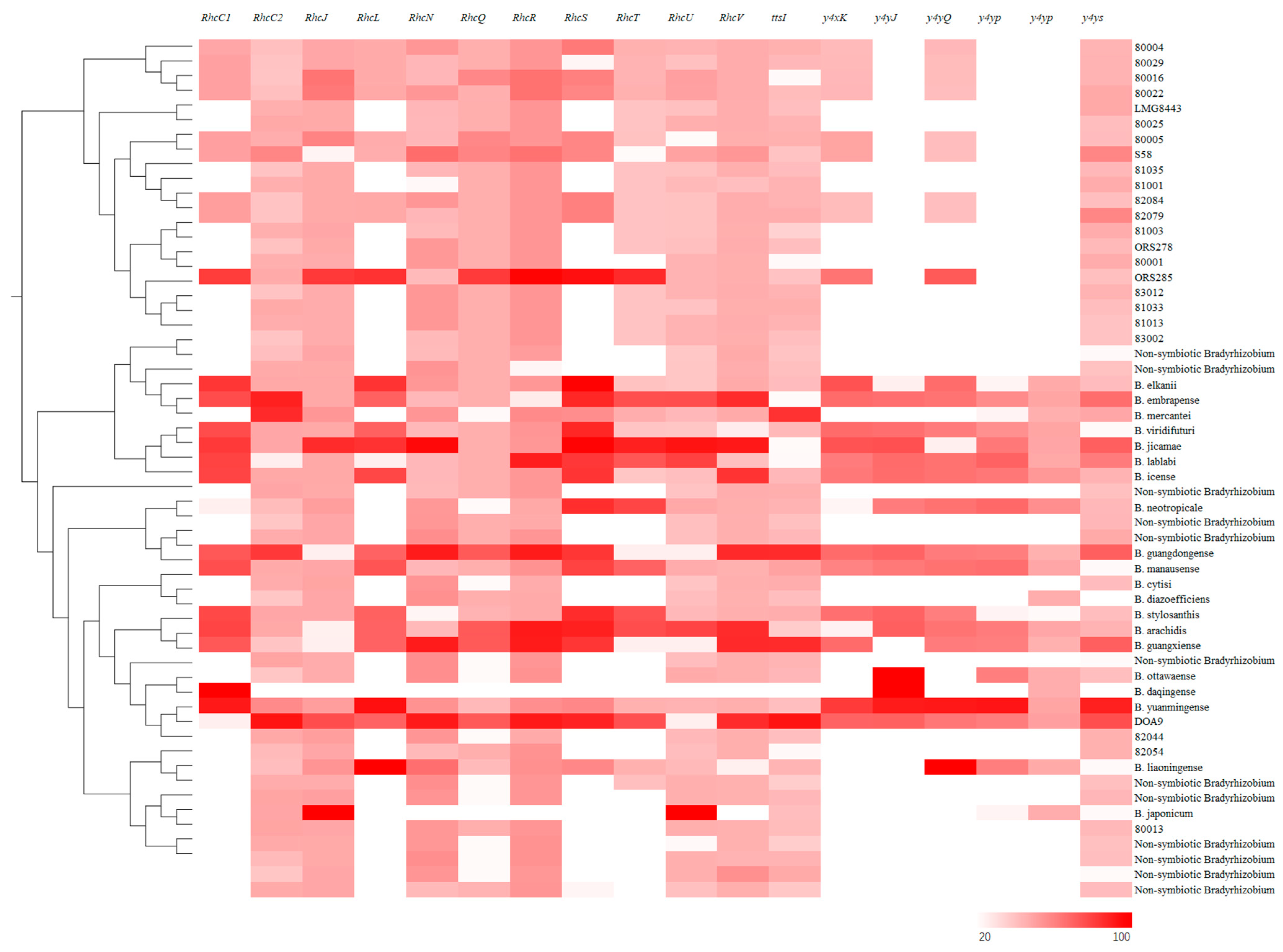
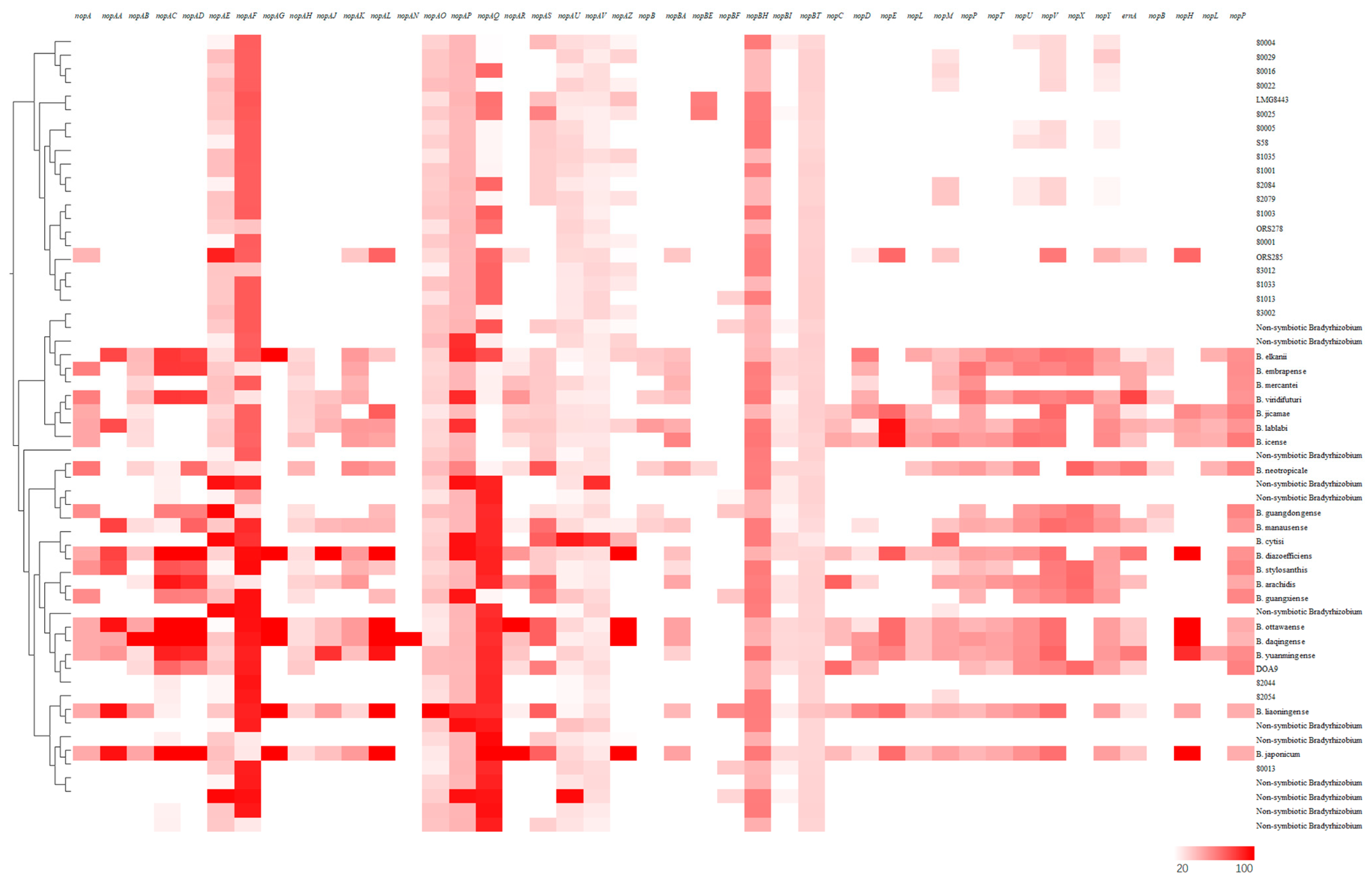

| Strain | Scaffolds | Longest Scaffold | Genome Size | (G + C)% | N90 |
|---|---|---|---|---|---|
| Aeschynomene indica rhizobia | |||||
| B. denitrificans 80005 | 168 | 478,427 | 8.8 M | 64.58 | 47,941 |
| B. oligotrophicum 80025 | 66 | 1,331,888 | 7.9 M | 65.22 | 175,316 |
| B. oligotrophicum LMG8443T | 102 | 491,180 | 8.3 M | 64.75 | 55,376 |
| B. oligotrophicum S58T | 1 | 8,264,165 | 8.3 M | 65.13 | 8,264,165 |
| Bradyrhizobium sp. I 82044 | 45 | 880,514 | 6.9 M | 64.55 | 113,255 |
| Bradyrhizobium sp. I 82054 | 58 | 887,869 | 7.0 M | 64.62 | 72,231 |
| Bradyrhizobium sp. II 80013 | 65 | 819,284 | 7.2 M | 64.83 | 117,592 |
| Bradyrhizobium sp. III 80001 | 141 | 712,781 | 7.7 M | 65.67 | 35,344 |
| Bradyrhizobium sp. IV 81033 | 59 | 711,146 | 7.5 M | 65.48 | 113,462 |
| Bradyrhizobium sp. V 80016 | 75 | 979,362 | 7.8 M | 65.00 | 136,370 |
| Bradyrhizobium sp. V 80022 | 54 | 2,692,961 | 7.8 M | 65.02 | 252,498 |
| Bradyrhizobium sp. V 80029 | 80 | 1,354,028 | 7.9 M | 65.00 | 247,781 |
| Bradyrhizobium sp. VI 80004 | 61 | 671,467 | 7.9 M | 64.77 | 106,416 |
| Bradyrhizobium sp. VII 81001 | 112 | 619,092 | 6.6 M | 65.48 | 45,649 |
| Bradyrhizobium sp. VII 81035 | 100 | 769,653 | 7.1 M | 65.62 | 83,941 |
| Bradyrhizobium sp. VII 82079 | 69 | 676,485 | 7.4 M | 65.42 | 80,746 |
| Bradyrhizobium sp. VII 82084 | 52 | 1,331,153 | 7.5 M | 65.48 | 125,140 |
| Bradyrhizobium sp. VIII 81003 | 46 | 1,209,915 | 7.4 M | 65.78 | 130,606 |
| Bradyrhizobium sp. VIII 81013 | 58 | 768,856 | 7.5 M | 65.51 | 155,814 |
| Bradyrhizobium sp. VIII 83002 | 59 | 1,045,725 | 7.5 M | 65.42 | 150,740 |
| Bradyrhizobium sp. VIII 83012 | 58 | 1,487,792 | 7.5 M | 65.54 | 115,572 |
| Bradyrhizobium sp. ORS 278 | 1 | 7,456,587 | 7.5 M | 65.51 | 7,456,587 |
| Bradyrhizobium sp. ORS 285 | 301 | 212,771 | 7.6 M | 65.23 | 13,681 |
| Bradyrhizobium sp. DOA9 | 2 | 7,114,464 | 7.9 M | 64.49 | 7,114,464 |
| Non-A. indica symbiotic rhizobia | |||||
| B. arachidis LMG26795T | 98 | 839,589 | 9.8 M | 63.63 | 70,254 |
| B. cytisi CTAW11T | 186 | 436,932 | 8.9 M | 63.17 | 35,919 |
| B. daqingense CGMCC1.10947T | 107 | 742,797 | 7.9 M | 63.73 | 38,665 |
| B. diazoefficiens USDA110T | 1 | 9,105,828 | 9.1 M | 64.06 | 9,105,828 |
| B. elkanii USDA76T | 2 | 9,116,505 | 9.5 M | 63.72 | 9,116,505 |
| B. embrapense SEMIA6208T | 36 | 1,556,835 | 8.3 M | 63.98 | 139,684 |
| B. guangdongense CCBAU51649T | 2 | 7,456,045 | 8.4 M | 63.26 | 981,946 |
| B. guangxiense CCBAU53363T | 2 | 7,220,948 | 8.2 M | 63.91 | 979,173 |
| B. icense LMTR13T | 1 | 8,322,773 | 8.3 M | 62.03 | 8,322,773 |
| B. japonicum USDA6T | 1 | 9,207,384 | 9.2 M | 63.67 | 9,207,384 |
| B. jicamae PAC68T | 235 | 238,143 | 8.7 M | 62.40 | 22,567 |
| B. lablabi CCBAU23086T | 135 | 408,238 | 8. M | 62.63 | 33,805 |
| B. liaoningense CCBAU05525T | 1040 | 62,700 | 8.1 M | 63.80 | 4068 |
| B. manausense BR3351T | 127 | 850,526 | 9.1 M | 62.87 | 47,046 |
| B. mercantei SEMIA6399T | 72 | 1,570,373 | 8.8 M | 63.99 | 259,995 |
| B. neotropicale BR10247T | 125 | 440,229 | 8.7 M | 63.60 | 42,996 |
| B. ottawaense OO99T | 1 | 8,606,328 | 8.6 M | 63.83 | 8,606,328 |
| B. stylosanthis BR 446T | 22 | 2,454,055 | 8.8 M | 64.56 | 237,570 |
| B. viridifuturi SEMIA690T | 152 | 399,926 | 8.8 M | 64.03 | 50,014 |
| B. yuanmingense CCBAU10071T | 108 | 1,099,763 | 8.2 M | 63.77 | 37,101 |
| Non-symbiotic Bradyrhizobium | |||||
| B. betae PL7HG1T | 2 | 7,150,095 | 7.41 M | 64.36 | 7,150,095 |
| Bradyrhizobium sp. AT1 | 8 | 7,515,445 | 7.5 M | 64.56 | 7,515,445 |
| Bradyrhizobium sp. BF49 | 1 | 7,547,693 | 7.5 M | 63.77 | 7,547,693 |
| Bradyrhizobium sp. G22 | 20 | 9,022,917 | 9.1 M | 63.73 | 9,022,917 |
| Bradyrhizobium sp. LTSP849 | 57 | 599,414 | 8.5 M | 63.24 | 131,906 |
| Bradyrhizobium sp. LTSP857 | 50 | 993,329 | 8.4 M | 63.29 | 106,609 |
| Bradyrhizobium sp. LTSP885 | 43 | 1,049,129 | 7.9 M | 63.39 | 116,147 |
| Bradyrhizobium sp. LTSPM299 | 100 | 682,398 | 9.1 M | 62.82 | 59,442 |
| Bradyrhizobium sp. OK095 | 51 | 1,094,326 | 7.8 M | 63.89 | 157,651 |
| Bradyrhizobium sp. S23321 | 1 | 7,231,841 | 7.2 M | 64.30 | 7,231,841 |
| Bradyrhizobium sp. URHA0002 | 144 | 405,618 | 7.0 M | 62.20 | 26,273 |
| Bradyrhizobium sp. YR681 | 351 | 167,815 | 7.8M | 64.72 | 11,443 |
| Taxa | Number of Homologous Gene Families with Differences | Number of KEGG Pathways | Number of Exclusive Access Points | Typical Pathways |
|---|---|---|---|---|
| Aeschynomene indica rhizobia | 1877 | 159 | 16 | Bacterial infestation of epithelial cells, carotenoid synthesis, Nod-like receptor signaling pathway, O-glycan biosynthesis, photosynthesis, plant–pathogen interactions, protein transport, etc. |
| Reference strains | 5211 | 221 | 68 | Bacterial secretion systems, biofilm synthesis, swarm-sensing effects, etc. |
Disclaimer/Publisher’s Note: The statements, opinions and data contained in all publications are solely those of the individual author(s) and contributor(s) and not of MDPI and/or the editor(s). MDPI and/or the editor(s) disclaim responsibility for any injury to people or property resulting from any ideas, methods, instructions or products referred to in the content. |
© 2024 by the authors. Licensee MDPI, Basel, Switzerland. This article is an open access article distributed under the terms and conditions of the Creative Commons Attribution (CC BY) license (https://creativecommons.org/licenses/by/4.0/).
Share and Cite
Zhao, M.; Dong, J.; Zhang, Z.; Wang, E.; Wang, D.; Xie, H.; Wang, C.; Xie, Z. Nodulating Aeschynomene indica without Nod Factor Synthesis Genes: In Silico Analysis of Evolutionary Relationship. Agronomy 2024, 14, 1295. https://doi.org/10.3390/agronomy14061295
Zhao M, Dong J, Zhang Z, Wang E, Wang D, Xie H, Wang C, Xie Z. Nodulating Aeschynomene indica without Nod Factor Synthesis Genes: In Silico Analysis of Evolutionary Relationship. Agronomy. 2024; 14(6):1295. https://doi.org/10.3390/agronomy14061295
Chicago/Turabian StyleZhao, Mengguang, Jingyi Dong, Zhenpeng Zhang, Entao Wang, Dandan Wang, Huijie Xie, Chao Wang, and Zhihong Xie. 2024. "Nodulating Aeschynomene indica without Nod Factor Synthesis Genes: In Silico Analysis of Evolutionary Relationship" Agronomy 14, no. 6: 1295. https://doi.org/10.3390/agronomy14061295





